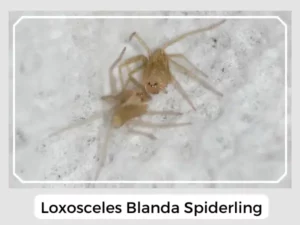Have you heard of the big bend recluse spider? This spider is part of the Sicariidae spiders family and calls North America its home. If you’re curious about this spider, you’re in the right place! We’ve got some amazing facts to share with you.
Their eggs are laid inside a sac made of webbing.
Spiderlings resemble tiny versions of adults.

Photo Credit: Kevin Lentz
Similar to other recluse spiders, they generate off-white webbing from their spinnerets.
Yes, Big Bend Recluse Spiders are venomous. They use their venom to help catch their food. However, they are not aggressive towards humans.
Yes, they can! While they are not known to bite except when threatened, their venom is potentially deadly like all other recluse spiders. It’s better to handle them carefully.
Ecologically, Big Bend Recluse Spiders are significant as natural pest controllers. They help maintain the insect population by preying on common pests such as cockroaches, crickets, flies, and moths. They exhibit nocturnal behavior, hunting for prey at night and remaining hidden during the day.
Natural Predators: Birds, cats, and even other spiders are among the natural predators of the Big Bend Recluse. These predators help to keep the spider’s population in balance within their natural habitat.
Prey-Predator Dynamics: The existence of the Big Bend Recluse Spider within the food web is crucial. They manage the populations of their prey, which in turn affects the distribution of their predators, illustrating the interconnectedness of ecological communities.
Relationship with Humans: The Big Bend Recluse Spider is venomous, and while it is typically not aggressive, it can bite when threatened. Caution is advised when in areas where they may dwell. However, due to their preference for dark and undisturbed places, encounters with humans are relatively rare.
| Lifespan | 1-2 years |
| Distribution | The United States, ranging throughout New Mexico to Texas as well as Mexico |
| Habitat | Dark, dingy areas like basements, cellars, and cupboards |
| Common Predators | Birds, cats, and other spiders |
| Diet | Cockroaches, crickets, flies, and moths |
In summary, the Big Bend Recluse Spider plays an integral role in the ecosystem as a predator of insects.
Have you heard of the big bend recluse spider? This spider is part of the Sicariidae spiders family and calls North America its home. If you’re curious about this spider, you’re in the right place! We’ve got some amazing facts to share with you.
Their eggs are laid inside a sac made of webbing.
Spiderlings resemble tiny versions of adults.

Photo Credit: Kevin Lentz
Similar to other recluse spiders, they generate off-white webbing from their spinnerets.
Yes, Big Bend Recluse Spiders are venomous. They use their venom to help catch their food. However, they are not aggressive towards humans.
Yes, they can! While they are not known to bite except when threatened, their venom is potentially deadly like all other recluse spiders. It’s better to handle them carefully.
Ecologically, Big Bend Recluse Spiders are significant as natural pest controllers. They help maintain the insect population by preying on common pests such as cockroaches, crickets, flies, and moths. They exhibit nocturnal behavior, hunting for prey at night and remaining hidden during the day.
Natural Predators: Birds, cats, and even other spiders are among the natural predators of the Big Bend Recluse. These predators help to keep the spider’s population in balance within their natural habitat.
Prey-Predator Dynamics: The existence of the Big Bend Recluse Spider within the food web is crucial. They manage the populations of their prey, which in turn affects the distribution of their predators, illustrating the interconnectedness of ecological communities.
Relationship with Humans: The Big Bend Recluse Spider is venomous, and while it is typically not aggressive, it can bite when threatened. Caution is advised when in areas where they may dwell. However, due to their preference for dark and undisturbed places, encounters with humans are relatively rare.
| Lifespan | 1-2 years |
| Distribution | The United States, ranging throughout New Mexico to Texas as well as Mexico |
| Habitat | Dark, dingy areas like basements, cellars, and cupboards |
| Common Predators | Birds, cats, and other spiders |
| Diet | Cockroaches, crickets, flies, and moths |
In summary, the Big Bend Recluse Spider plays an integral role in the ecosystem as a predator of insects.